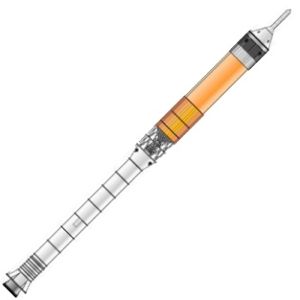
Home - Search - Browse - Alphabetic Index: 0- 1- 2- 3- 4- 5- 6- 7- 8- 9
A- B- C- D- E- F- G- H- I- J- K- L- M- N- O- P- Q- R- S- T- U- V- W- X- Y- Z
Ares I-X
 CLV Credit: © Mark Wade |
AKA: Ares I;CLV;Crew Launch Vehicle. Status: Active. First Launch: 2009-10-28. Last Launch: 2009-10-28. Number: 1 . Payload: 24,500 kg (54,000 lb). Thrust: 13,963.44 kN (3,139,107 lbf). Gross mass: 907,000 kg (1,999,000 lb). Height: 94.20 m (309.00 ft). Diameter: 3.77 m (12.36 ft). Span: 5.50 m (18.00 ft). Apogee: 160 km (90 mi).
In the initial September 2005 design the 160 metric ton upper stage was powered by an expendable version of the Shuttle SSME engine and supported by a Russian-type open Warren-truss interstage. A relatively unmodified single four-segment shuttle solid rocket booster would provide the first stage. By August 2006 the expense of the SSME and weight growth in the CEV forced NASA to switch to the J-2S engine powering a 127 metric ton second stage, and a five-segment version of the SRB in the first stage. A conventional 'American' interstage was now shown.
LEO Payload: 24,500 kg (54,000 lb) to a 160 km orbit at 28.00 degrees. Payload: 25,000 kg (55,000 lb) to a 350 km 51.6 deg orbit.
More at: Ares I-X.
Family: heavy-lift, orbital launch vehicle. Country: USA. Spacecraft: Ares spaceplane, Orion. Launch Sites: Cape Canaveral LC39B. Stages: Ares Stage 2, RSRM. Agency: NASA.
2009 October 28 - . Launch Site: Cape Canaveral. Launch Complex: Cape Canaveral LC39B. Launch Platform: MLP1. LV Family: Shuttle. Launch Vehicle: Ares I-X.
- Ares I-X - .
Nation: USA.
Agency: Clemson.
Spacecraft Bus: FLTP/FESTIP.
Spacecraft: Ares spaceplane.
First flight test of the Ares/Constellation program. The Ares I-X rocket consisted of the modified Shuttle RSRM-91A solid rocket booster, a dummy Upper Stage Simulator, and a dummy Ares command module / launch abort system. It was launched from the newly modified LC39B at Kennedy Space Center to test the aerodynamics of the vehicle within the atmosphere and provide real-world data to ameliorate concerns regarding the vibration level created by the SRB for any crew in a future mission. The SRB reached 46 km altitude before descending to the Atlantic for recovery.
Back to top of page
Home - Search - Browse - Alphabetic Index: 0- 1- 2- 3- 4- 5- 6- 7- 8- 9
A- B- C- D- E- F- G- H- I- J- K- L- M- N- O- P- Q- R- S- T- U- V- W- X- Y- Z
© 1997-2019 Mark Wade - Contact
© / Conditions for Use